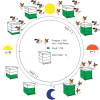Modelling daily weight variation in honey bee hives
- PMID: 36857336
- PMCID: PMC9977058
- DOI: 10.1371/journal.pcbi.1010880
Modelling daily weight variation in honey bee hives
Abstract
A quantitative understanding of the dynamics of bee colonies is important to support global efforts to improve bee health and enhance pollination services. Traditional approaches focus either on theoretical models or data-centred statistical analyses. Here we argue that the combination of these two approaches is essential to obtain interpretable information on the state of bee colonies and show how this can be achieved in the case of time series of intra-day weight variation. We model how the foraging and food processing activities of bees affect global hive weight through a set of ordinary differential equations and show how to estimate the parameters of this model from measurements on a single day. Our analysis of 10 hives at different times shows that the estimation of crucial indicators of the health of honey bee colonies are statistically reliable and fall in ranges compatible with previously reported results. The crucial indicators, which include the amount of food collected (foraging success) and the number of active foragers, may be used to develop early warning indicators of colony failure.
Copyright: © 2023 Arias-Calluari et al. This is an open access article distributed under the terms of the Creative Commons Attribution License, which permits unrestricted use, distribution, and reproduction in any medium, provided the original author and source are credited.
Conflict of interest statement
The authors have declared that no competing interests exist.
Figures






References
-
- Goulson D, Nicholls E, Botías C, Rotheray EL. Combined stress from parasites, pesticides and lack of flowers drives bee declines. Science. 2015;347(6229):1255957. - PubMed
-
- Hladik ML, Main AR, Goulson D. Environmental risks and challenges associated with neonicotinoid insecticides; 2018. - PubMed
-
- Le Conte Y, Ellis M, Ritter W. Varroa mites and honey bee health: can Varroa explain part of the colony losses? Apidologie. 2010;41(3):353–363. doi: 10.1051/apido/2010017 - DOI
Publication types
MeSH terms
LinkOut - more resources
Full Text Sources
Medical

